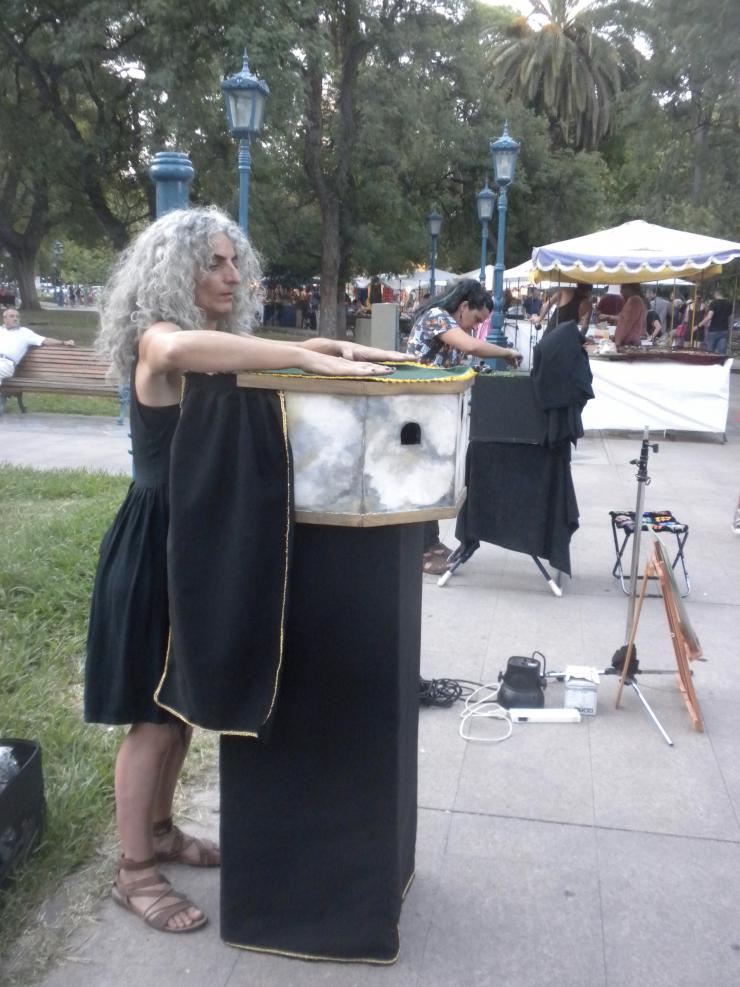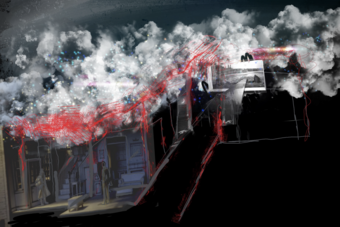The Smallest Theatre in the World
An Interview with Caja lambe-lambe artist Gabriela Céspedes / El Teatro Más Pequeño del Mundo: Una entrevista con la artista de caja lambe-lambe Gabriela Céspedes
This interview has been translated from Spanish and condensed and edited for clarity.
Caja lambe-lambe is a style of puppetry invented in the late 1980’s by Brazilian puppeteers Denisse do Santos and Ismine Lima. It usually takes the form of a one to three-minute long show performed inside of a box (or another container) for a single spectator who watches through a peephole, and listens to the accompanying music or speech through headphones. This style of theatre is now popular throughout Latin America and is sometimes called caja magica or caja misteriosa. Gabriela Céspedes is a lambe-lambe artist and teacher based in Mendoza, Argentina. I studied caja lambe-lambe with her at the Global Convocation of Women Puppeteers held in Neuquén, Argentina in November 2014 and recently returned to see her work in Mendoza, where I conducted this interview.
Cecilia Cackley: Where did you first see or learn about caja lambe-lambe?
Gabriela Céspedes:I first saw the form in Bolivia in 2004, from Argentine people who were traveling through. I already knew about the technique called lambe-lambe from a Colombian friend and colleague of mine who knew the technique, had constructed a show and told me how it worked. I really liked the idea of working with miniatures and putting them in a box so that an observer is looking at the story from the outside. In the beginning of 2012 here in Mendoza, we organized a ten day workshop during a small festival and with the excuse of the festival, we hired a Brazilian puppeteer, Luciano Bugmann, who lived in Chile at that time when he was part of the group Oani Teatro, (today he’s part of the group Teatro Mestre Luna) to give a ten-day workshop here on lambe-lambe theatre.
I believe that there are thousands of ways, forms, aesthetics, and mechanics for building a caja show. And the miniature scale is no obstacle, you can build fantastical, neutral, or very realistic worlds. / Creo que hay mil maneras, mil formas, mil estéticas, mil mecánicas para poder realizar una caja. Y la miniatura no es obstáculo para nada, podes realizar mundos fantásticos, neutros, mundos muy reales.—Gabriela Céspedes
Cecilia: How is lambe-lambe theatre different from other forms of theatre?
Gabriela: The difference from my point of view, for one is the intimate format. And for another, how it affects the eye of the spectator. It’s not the same to do an open show where the eye of the spectator is free to see 180 degrees and observe the show at 180 degrees. When it’s a reduced space, that affects the eye of the spectator because the musculature of the eye provokes in that instance a different relationship between spectator and what they are seeing, the synapsis is different. Those two points are the most important part of lambe-lambe theatre, that makes it different from other puppet theatre.
Cecilia: What are the major challenges when creating a lambe-lambe show? Gabriela: I believe that there are thousands of ways, forms, aesthetics, and mechanics for building a caja show. And the miniature scale is no obstacle, you can build fantastical, neutral, or very realistic worlds. What’s important is to be very clear about the story of the show, and to know if you want to reveal the mechanical part of the box and the effects to the spectator, or if you want to hide them. The difficulty is figuring how to include all the technical elements so the spectator believes in the story. That's the most difficult part of a caja show.
Cecilia: Finding a balance.
Gabriela: Yes, that balance between the technique and the aesthetic. There can’t be a large number of items inside the box because then it’s difficult to tell a clear story. If you have lots of color, images, everything mixed together, or lots of things moving at once in such a small space, you’re going to lose the spectator.
Cecilia: What kinds of opportunities are there to perform caja in South America? Gabriela: Right now in South America there is a festival that is very important that happens in Valparaiso in April. In Brazil there are many festivals and now in Argentina, there are people interested in organizing some festivals. In Chaco, an Argentine province, there is a very nice festival that is in its third year, in 2017. These are festivals that are only for caja theatre. Many puppet festivals are now inviting some caja shows to showcase a different technique of puppet theatre from the big shows for the general public. Then, for performing caja theatre, there are many alternatives, such as museums, fairs, book festivals, public spaces like plazas or pedestrian areas, private parties, galleries, or the lobbies of theatres before a show starts. There is a wide spectrum of places where you can perform caja.

Cecilia: What kinds of stories do you like to tell with your shows?
Gabriela: Up until now they have all been very different. My first caja show was a very abstract, poetic story about a feather; each spectator interpreted the story according to what they understood in the moment. My second box was the story of Vladimir, a vampire, who was inspired by the character Dracula. It’s a story that I always say is “Hollywood” inspired by many characters; in the book Dracula by Bram Stoker and in the movies that I love, for example Nosferatu, and the first movies about vampires. In the span of two minutes and thirty seconds, all those stories are concentrated in this tiny story. And then the others are always something different. For example, the erotic shows I just finished presenting. The shows can also be inspired by an image. In reality, the puppet theatre lambe-lambe can talk about an infinity of themes.
Cecilia: Where can artists find more information about caja lambe-lambe?
Gabriela: On the internet you can find lots of information; there are many recordings of shows on YouTube. On the internet there are people who have tutorials that you can follow to create your own caja show, there’s one by Oani Teatro, from Chile. There is a very interesting book called Cajas Misteriosas en Mexico that you can find on the internet too that is written by Cesar Tavera, a Mexican puppeteer. It’s very interesting because it’s very comprehensive and in some ways, it’s creating the history of lambe-lambe. But the best way to know lambe-lambe theatre is to watch lambe-lambe in real life. You can watch shows on YouTube and all over the internet, but when you see those same shows in real life, it’s marvelous and changes you completely.
***
Caja lambe-lambe es un estilo de títeres que apareció en los años ochenta por las titiriteras brasileñas Denisse do Santos e Ismine Lima. Toma la forma de una función que dura entrre uno y tres minutos y ocurre dentro de una cajita para un solo espectador, quien mira a través de un visor y escucha la música por audífonos. Este estilo de teatro ahora es popular por toda Latinoamérica, y a veces se llama caja mágica o caja misteriosa. Gabriela Céspedes es una artista de lambe-lambe y una maestra de títeres de Mendoza, Argentina. Estudié con ella durante la Convocatoria Mundial de Mujeres Titiriteras en Neuquén, Argentina en noviembre del 2014 y recientemente regresé a Mendoza donde hicimos esta entrevista.
Cecilia: ¿Donde fue la primera vez que viste o aprendiste sobre caja lambe-lambe?Gabriela Céspedes: Vi una cajita en Bolivia por el año 2004, de gente de Argentina que estaba pasando allá. Yo ya conocía la técnica con el nombre de lambe-lambe, ya que un amigo y colega colombiano, conocía la técnica y estaba construyendo una cajita y me contó cómo funcionaba. A mí me gustó muchísimo la idea de poder trabajar con miniaturas y guardarlas, dentro de una caja y que un observador este mirando la historia desde afuera. Ya después en principios del 2012 aquí en Mendoza organizamos un taller de teatro lambe lambe de 10 días, durante un festival. Convocamos al titiritero brasileño, Luciano Bugmann, que vivía en Chile en ese momento y dictó el taller. El perteneció al grupo Oani Teatro (hoy pertenece al grupo Teatro Mestre Luna).
Cecilia: ¿Cómo se distingue el teatro lambe-lambe a otras formas de teatro?
Gabriela: Lo distinto, en mi punto de vista, por un lado es el formato íntimo. Y por otro, es como afecta al ojo del espectador. No es lo mismo hacer un espectáculo para un público abierto donde el ojo del espectador está puesto a mirar a 180 grados, aunque sea un espacio reducido, que a obligar a que observe por una mirilla. La musculatura del ojo provoca, en esa situación, otra relación del espectador con lo que está viendo, la sinapsis es distinta. Estas dos premisas son importantes para que el teatro lambe lambe se diferencie de otros teatro de títeres.
Cecilia: ¿Cuales son los mayores obstáculos en cuanto a crear una obra de caja?
Gabriela: Creo que hay mil maneras, mil formas, mil estéticas, mil mecánicas para poder realizar una caja. Y la miniatura no es obstáculo para nada, podes realizar mundos fantásticos, neutros, mundos muy reales. Lo importante es que uno pueda tener claro en la dramaturgia de la caja la parte mecánica y la parte de efectos, si el intérprete quiere revelarlas al espectador o las quieres esconder. Lo difícil es cómo articular todo lo técnico para que la espectadora pueda creer la historia, eso es lo más difícil de una caja.
Cecilia: Descubrir un equilibrio.
Gabriela: Claro, ese equilibrio entre lo técnico y lo estético. No debe haber un montón de cosas dentro de la caja, porque es difícil ser claro en el momento de narrar la historia. Si tienes mucho color, mucha imagen, todo mezclado, muchas cosas moviéndose a la vez, en un espacio tan pequeño, haces que el espectador se pierda en la historia.
Cecilia: ¿Qué tipo de oportunidades hay para hacer caja en Sudamérica?
Gabriela: Ahora acá en Sudamérica hay un festival que está siendo muy importante, se hace en Valparaíso y es en abril. En Brasil hay muchos festivales y en Argentina ahora hay gente que está interesada en organizar algunos festivales. En el Chaco, provincia Argentina, hay un festival muy lindo que va a llevar su tercera edición este año 2017. Igual en muchos festivales de teatro de títeres en general están invitando también algunas cajitas como técnica de teatro de títeres diferente al espectáculo para público en general. Después para poder presentar las cajitas, hay muchas alternativas, museos, ferias, ferias de libros, plazas públicas, peatonales, fiestas privadas, salas o las antesalas de los teatros antes de empezar las funciones. Hay un amplio espectro de lugares donde se puede presentar una caja.
Cecilia: ¿Qué tipo de historias te gusta contar con tus obras?
Gabriela: Hasta ahora han sido muy diferentes. Mi primer caja fue una historia mucho más abstracta, era la historia de una pluma, muy poética, que cada uno de las espectadores interpretaba la historia según lo que cada uno entendió en su momento. La segunda fue la historia de “Bladimir”, una historia de vampiros, que fue inspirada por el personaje de Drácula. Es una historia que siempre digo que es “Hollywood,” y está inspirada también en muchos personajes: del libro de Drácula de Bram Stoker y en las películas que me encantan, por ejemplo Nosferatu o las primeras películas de vampiros. En esta micro historia de dos minutos treinta, concentre todas estas historias. Y luego las otras siempre son disparadas a través de una idea, por ejemplo las cajas eróticas que acabo de estrenar; también las obras pueden surgir a partir de un imagen. En realidad en el teatro de títeres lambe-lambe podemos hablar de una cantidad infinita de temas.
Cecilia: ¿Donde se puede descubrir más información sobre caja lambe-lambe?Gabriela: Se puede conseguir bastante información en internet, hay muchos espectáculos en YouTube. En internet hay gente que tiene tutoriales para crear tu propia función de caja como el caso de Oani Teatro, de Chile. Hay un libro muy interesante que se llama Cajas Misteriosas en México de César Tavera, que lo pueden encontrar en internet. Es muy interesante porque es bastante completo y de cierta manera está creando la historia de lambe-lambe. Pero la mejor manera de conocer el teatro lambe-lambe es verlo en vivo. Es el mejor porque los espectáculos en YouTube e internet se ven pero cuando es en vivo es maravilloso, cambia totalmente.










Comments
The article is just the start of the conversation—we want to know what you think about this subject, too! HowlRound is a space for knowledge-sharing, and we welcome spirited, thoughtful, and on-topic dialogue. Find our full comments policy here